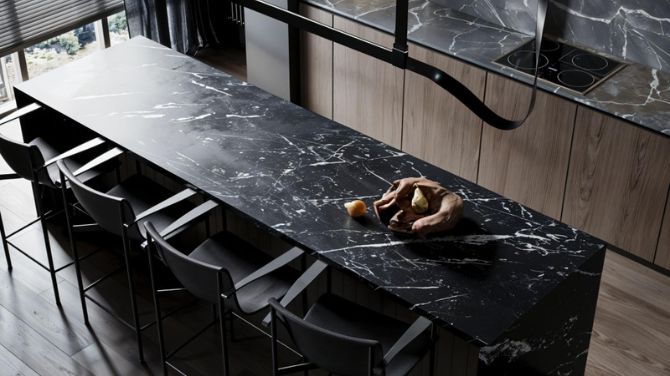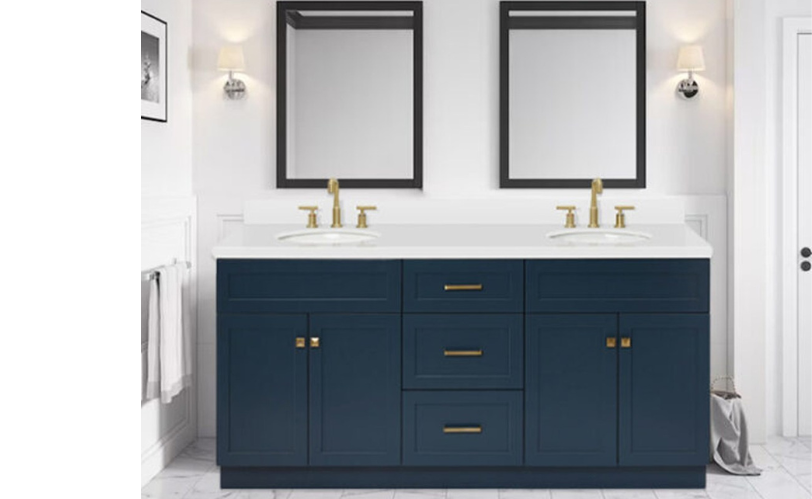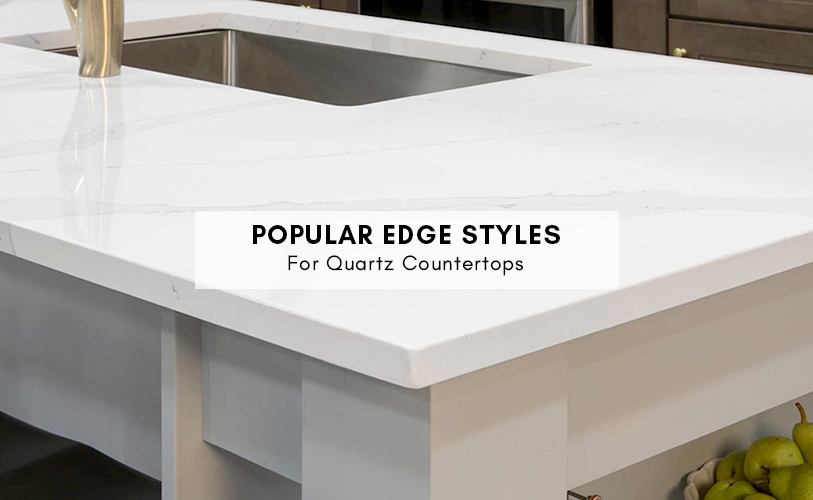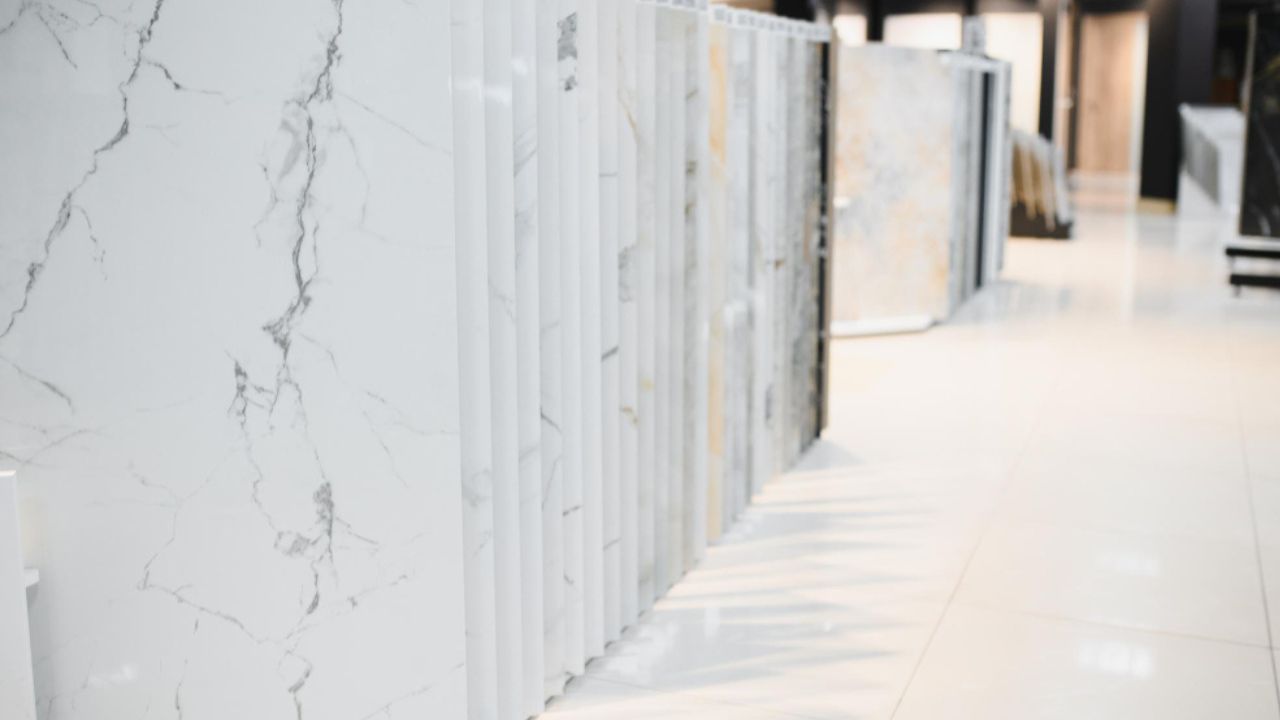Mitered Edge Countertops: Pros & Cons | Where to Use This
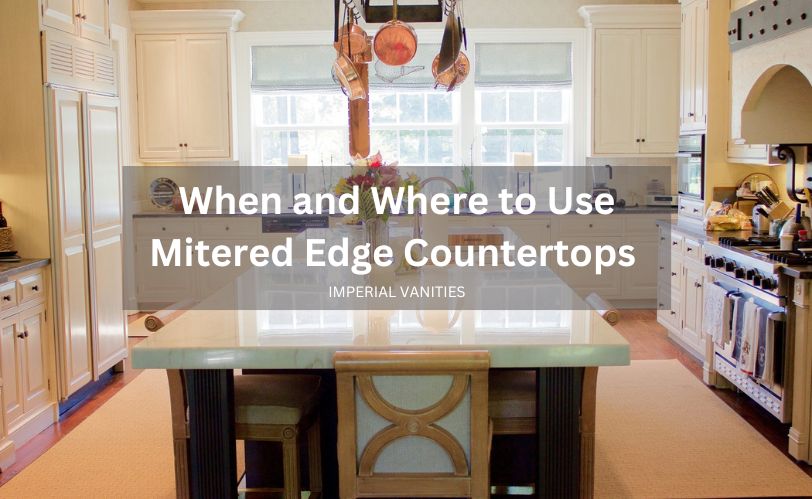
Whenever you redesign your kitchen, you want every corner to look beautiful and perfect, such as mitered edge countertops, perfectly fitted cutting, jointless design and clean marble or granite slabs. Often we focus on choosing the best countertop for the kitchen, but do not pay much attention to its edging and finishing, which is very important to give the countertop a perfect look.
In this blog, we will tell you about the most preferred edge designs for quartz countertops. Along with this, we will also explain their advantages, disadvantages and where they are used in simple language. So let’s move ahead!
What is Mitered Edge Format?
The top quartz kitchen countertop area is joined to a lower, flat fraction of the countertop by mitering the two parts at 45-degree angles and fusing them together. This creates a seamless, flawless 90-degree edge. When combined with a waterfall panel, a mitered edge profile gives the impression of a thicker slab of granite or stone. You can ask an expert countertop supplier like Imperial Vanities to add a mitered edge profile to your quartz edges, which is different from a square edge. You can select an apron size of 2 to 6 cm—the apron is the component that hangs down vertically. The thickness of an apron increases its impression. Another option is a mitered edge countertop, which provides a rounded appearance where the two pieces meet. Know more about Mitered Edge Countertops in detail through this blog.
Benefits of Countertop
Enhances the aesthetics of a kitchen or bathroom
In terms of aesthetic appreciation, mitered edge countertops integrate beauty and function by offering a subtle and polished finish. Whether it is in the kitchen or bathroom, the joint’s precise 45-degree angle provides a modern, sleek and luxurious look. The smooth, joint-free edges create a seamless look, enhancing the material’s elegance while keeping it clean and unbroken. This mitered edge design adds a sleek look to the space while blending naturally with the overall design.
Gives the Appearance of Being Thicker Or Leads to the Edge of a Waterfall
Mitered edge countertops can give the impression of being thicker than they actually are. The mitered edge technique makes the countertop look thicker by joining two layers, unlike traditional countertops that use a single layer. This is even more breathtaking when used in conjunction with the waterfall edge, which displays a countertop that flows down the sides of an island or cabinet. The smooth, continuous design makes the room look stylish and eye-catching. This eye-catching effect makes a statement in contemporary kitchen designs as well.
Less Expensive Than a Brand-New Piece of Marble, Granite, or Another Material
Opting for a mitered edge countertop allows one to achieve a thicker appearance without paying for full slabs of natural stone. Instead of a buying a solid thick slab, the mitered edge technique allows fabricators to use a standard thickness slab and fabricate a thicker profile by joining two pieces together at an angle. This significantly reduces material costs while maintaining the look of a premium full slab countertop.
Provides a statement or a focal point for the area or space
Mitered edge countertops instantly grab attention and become the highlight of any kitchen or bathroom. Their sleek, modern edges enhance the style of the kitchen or bathroom, adding a touch of sophistication.
Regardless of whether they are placed on a bar, bathroom vanity, or kitchen island, these units enhance the appearance of the area thereby making it attractive, and, at the same time, making the countertop a central design element that complements other décor and fixtures.
Complements Both Modern And Antique Styles
Mitered edges easily complement different styles, making them perfect for designs that mix various elements. They also enhance modern designs by highlighting the clean and sharp lines of a contemporary space. In classical spaces, they blend with classic cabinetry and rich textures. Mitered edge countertops can also complete a minimalist, industrial, and classic designed interiors, giving homeowners and designers the freedom to style the room any way they want.
Easy to Maintain and Clean Counters
Mitered edge countertops offer beauty with functionality by being extremely easy to maintain. Cleaning can be done swiftly because their midsection finish prevents dirt from clinging onto the edges. Keeping the countertops fresh only requires wiping with a damp cloth together with some soap. Compared to edges with artistic designs and complicated structures, mitered edges do have grooves and detailed carvings which require intensive cleanings. Moreover, mitered quartz countertops are non-porous which help them avoid getting stained, wet, and infected with bacteria. This helps keep them looking fresh and aid in maintaining hygiene.
Disadvantages of Countertops
More costly than a regular edge
The mitered edges are deemed to be the most expensive in comparison to other edges due to the fact that highly skilled craftsmanship and precise cutting is needed to achieve a seamless joint of 45 degrees. The higher cost comes from both the specialized tools required and the additional time and skill needed to achieve a flawless finish. This method is very different from eased or square edges, making it unique. Unlike the simpler styles of edges that use a single cut, the mitered edge style involves two slabs that are cut at an angle and joined together. This additional complexity makes them a preferred selection that may not be affordable to every one.
Needs a knowledgeable countertop installer
A perfect mitered edge is achieved by expert hands, as even the slightest misalignment can disrupt the seamless effect. For the perfect miter edge, two pieces must be cut accurately at 45-degree angles, perfectly aligned with each other, and an adhesive that can blend well with the material should be used. When applied incorrectly, visible seams, uneven edges, or weak joints may appear, compromising both aesthetics and durability. As such, it is critical for the homeowners to rely on a professional fabricator or a countertop specialist who has the experience and the knowledge regarding mitered edge countertops. The lack of skillful craftsman can results in highly expensive repairs or a complete reinstallation.
The cabinets underneath must support the additional countertop material
The mitered edges of a countertop, especially with the waterfall design, adds extra weight to the surface of the countertop. Unlike regular countertops which lie passively on cabinetry, the mitered edge countertop requires more stability to prevent structural collapse. Cabinets and base structures need to be reinforced in order to uphold the weight so no sagging or warping occurs over time. If the cabinets are not adjusted to handle the additional finances, then it may result in extra expenses and increased installation time.
Mitered Edge vs. Other Edge Profiles
| Features | Mitered Edge Countertop | Regular Edge Countertop |
| Appearance | Creates a seamless, thickened look by joining two slabs at a 45-degree angle. | It has a single, natural thickness with a straightforward finish. |
| Thickness | Appears thicker without using a solid, thick slab. | Thickness is based on the original slab size. |
| Aesthetic appeal | Modern and luxurious, often used for waterfall countertops. | Simple and classic, suitable for various styles. |
| Installation complexity | Requires precision cutting and expert craftsmanship. | Easier to fabricate and install. |
| Durability | Strong when installed correctly but depends on the seam quality. | Naturally sturdy as it is a single slab. |
| Cost | More expensive due to extra labor and precision cutting. | More affordable with lower fabrication costs. |
| Usage | Ideal for high-end kitchens, islands, and statement pieces. | Suitable for everyday kitchen and bathroom countertops. |
| Maintenance | Easy to clean but requires professional installation to avoid seam issues | Easy to maintain with no seam concerns. |
Uses of Mitered Edge Countertops
Different edge format countertops come with different applications and use. Anyone who considers getting mitered edge countertops must realize whether they are making the right choice or not.
Both the kitchen and bathroom have mitered edge countertops. Its design feature gives the room a point of reference and contrast. Mitered edges can be used to extend a countertop to the ground with a cascade panel, or to create a seamless transition between countertops of varying heights.
A regular mitered edge has a clear 90-degree angle, while an alleviated mitered edge has a somewhat rounded corner. You should consider both types before making a decision because even a small difference in the detailing can have a significant impact.
Thus, if you want to create a flawless kitchen design, you can rely on Imperial Vanities edge format countertops. We are experts in the countertop manufacturing and supplying industry, and know what kind of edging will be suitable. Apart from mitered edges, we will do any other formatting that your quartz edges need to fulfill your ‘dream kitchen customization. Contact us to know more about our services.
Pros and Cons of Mitered Edge Countertops
The sleek and sophisticated design of mitered edge countertops makes them very popular. Like any other design choice, they have their pros and cons. Let’s take a closer look at some of the many considerations:
Pros of Mitered Edge Countertops
- Seamless Look – One of the biggest advantages of a mitered edge countertop is its seamless appearance. The edges are cut at a 45-degree angle and fused together, creating an illusion of a single, continuous slab. This design enhances the elegance of the countertop, making it look flawless.
- Luxurious Appearance – Mitered edges are often used in high-end kitchen and bathroom designs. The added thickness and smooth transition between surfaces give a premium, sophisticated touch, making the space look more refined and stylish.
- Great for Thick Countertops – If you love the look of thick countertops but don’t want to invest in an expensive, solid thick slab, mitered edges are a great alternative. By joining two slabs at an angle, they create the illusion of a thicker slab without the extra weight and cost of a solid thick piece.
- Ideal for Waterfall Edges – Mitered edges work exceptionally well for waterfall countertops, where the stone extends from the counter’s surface down to the floor. The seamless transition makes the design look elegant and continuous.
- Complements Various Design Styles – Whether you prefer a modern, minimalist look or a more traditional, timeless aesthetic, mitered edges can be customized to fit different styles. They pair well with quartz, granite, and marble countertops, making them a versatile choice.
Cons of Mitered Edge Countertops
- Requires Precise Craftsmanship – Mitered edges are set apart by a different level of cutting and craftsmanship compared to regular edges. If the 45-degree angle joints are not properly aligned, cut, or fused together, the resultant edges will have gaps or weak joints. This makes it crucial to hire a skilled professional for installation.
- May Be Costlier – Due to the level of expertise, advanced cutting techniques, and additional labor involved, mitered edge countertops tend to be more expensive than standard edges. Furthermore, the intricate detailing and seamless finish add to the overall fabrication cost, making them a premium choice.
- Requires Strong Support – Since mitered edges give the appearance of a thicker slab, they add some weight to the countertop. The cabinets or base that is supporting the countertop must be strong enough to support the extra material. If not, the added weight can potentially cause structural issues in the long run.
- Seam Visibility Over Time – While the seams are initially well-hidden, in some cases, they may become slightly visible over time due to natural expansion, contraction, or regular wear and tear. Proper maintenance and professional installation help minimize this issue.
Mitered edge countertops are an excellent choice for those looking to add a modern and elegant touch to their kitchen or bathroom. However, it’s essential to consider both the aesthetic benefits and practical challenges before making a decision. Would you like any modifications or additional details?
How Different Materials Affect the Look and Durability
- Quartz – A popular choice for mitered edges, quartz offers a sleek, modern look with a consistent pattern. Since quartz is engineered, it allows for seamless joints, making the mitered edge appear flawless. It is highly durable, non-porous, and resistant to stains, scratches, and moisture, making it ideal for kitchens and bathrooms.
- Granite – Known for its natural beauty, granite adds a timeless and luxurious feel to countertops. A mitered edge enhances its bold veining and organic patterns, creating a striking focal point. While granite is highly durable and heat-resistant, it requires sealing to prevent stains and maintain longevity.
- Marble – If you seek an elegant and sophisticated appearance, marble is an excellent option. A mitered edge can showcase its natural veining beautifully. However, marble is softer and more porous than quartz and granite, making it susceptible to stains and scratches. Regular sealing and careful maintenance are necessary.
- Porcelain – A rising trend in countertop materials, porcelain provides a sleek, modern look with various color and pattern options. It is extremely durable, heat-resistant, and lightweight compared to natural stone. Porcelain’s adaptability makes it a great choice for mitered edges in both kitchens and bathrooms.
Best Material Choices for a Mitered Edge
- Quartz – Best for durability, seamless joints, and minimal maintenance.
- Granite – Ideal for those who want a natural look with strong durability.
- Porcelain – A lightweight option with heat and stain resistance.
- Marble – Perfect for those who prioritize elegance and aesthetics over durability.
When selecting the right material for a mitered edge countertop, consider factors such as durability, maintenance, budget, and aesthetic preferences.
Conclusion
Mitered edge countertops are among the most beautiful features one can have in the kitchen or the bathroom, as they provide a high-end finish and refinement to the area’s designs. The strength, beauty, and elegance depend on the selection of the material and can range from quartz to granite, marble, or porcelain.
Key Takeaways:
To any space, mitered edges add an elegant depth and dimension and provide a seamless integration to the surrounding design.
Flawless finish of mitered edges demands attention and focus from skilled craftsmen.
Different materials including quartz and granite or marble make aesthetically pleasing durable designs.
Looking for high-quality mitered edge countertops? Imperial Vanities specializes in premium countertops with expert craftsmanship. Contact us today to explore our collection and transform your space with luxurious, well-crafted surfaces!


